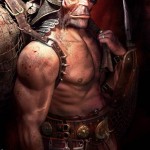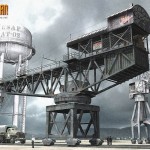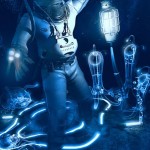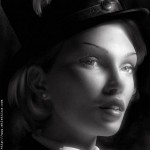Allessandro Baldasseroni
Interview from CGC Archive
This Italian combines the best technology has to offer and creates work that seems to be at the frontier between 2D and 3D. Enter the world of Alessandro Baldasseroni.
CGC: Can you give us a quick overview of your professional career?
Alessandro: I began as a CAD operator in a telecommunication company more than 7 years ago.
During the first three years I learned the fundamentals of 3D graphics on my own and started using 3d studio max. I later decided to transform my passion for CG into a career, so I submitted my portfolio to Milestone, where I still work today, and luckily, I was put in charge of 3D artists.
I have been in this field for almost 4 years now, so I am basically still an enthusiastic newbie!
CGC: Of all the work you have done over the past few years, what are you the most proud of?
Alessandro: There is a lot of my work that I am proud of. That is why I still feature most of my older work on my site. It illustrates the growth I have gone through over time. I love it all!
Probably the one I am the most proud of is an old work of mine dedicated to my best friend Alessandro aka Axa Mack P1 🙂
This was my first real 3D render. and it was the first time my work was published on an major site like 3D Café. I was very proud and happy when that happened. .In many ways, it gave me the strength to continue and made me realize that I could create 3D stuff that would be appreciated by a lot of people.
CGC: One of your renders called “His Majesty Vega”, your character almost seems to have a soul. What is he thinking of?
Alessandro: He’s the King Of Vega … inspired to the character in the Grendizer’s anime series by Go Nagai. He’s probably in deep thoughts about his Earth’s conquest plans. I like to think at him like an old conqueror, just a little bit sad and melancholic. Tired of thousands of battles, and just in need of some rest.
CGC: Would you mind telling us about your inspiration for this character and how he was made?
Alessandro: The basic look of him is clearly inspired by the anime character…then I tried to restyle him a bit, giving him a more serious and solemn look and trying to emphasize the contrast between a warm light from the left and a cold light from the right.
Technically the model is built completely in subdivision surfaces and uses the standard max rendering engine. I made some post effect corrections in the end, sharpening edges and adjusting hue/saturation in Photoshop.
CGC: Some of your latest renders almost have a 2D matte-painting quality to it. Would you mind shedding some light on your render/lighting techniques?
Alessandro: Well, my render pipeline doesn’t need that much resources. I seldom use time consuming processes like soft shadows, SSS and so on. Just because I prefer a more illustrative style rather than photorealism.
I tend to work a lot on mood and texturing instead, often doing a lot of post processing in the end to achieve the desired effect.
CGC: What sort of filters do you use for the grain?
Alessandro: In some pictures I just apply the traditional Gaussian monochromatic noise filter of photoshop
CGC: Would you mind sharing some production tips with our readers?
Alessandro: There is no secret at all…But here is a breakdown of my workflow.
1. I do a lot of research on Google for reference images or sketches to help focus on the essential elements of the scene and not get lost on unessential details.
2. I usually model blocking the main volumes and then go step by step to enhance the detail level. I don’t think you should waste time on details until you are satisfied with the general volumes, otherwise, you may have to go back and start over.
3. Texturing is another huge part of my work I tend to use photorealistic textures, but in many cases, I think that painted textures can give far better results.
4. Lighting and rendering must be as flexible as possible. So until you have an idea of the mood you want to achieve, it’s better to render with aliasing, low GI sampling (if not at all) and low size shadow maps… This gives you much more freedom to experiment. It seems obvious, but many beginners are inclined to pump all the values up and have a hard time calibrating the final output because of long render times.
5. Post production can make a HUGE difference to the final image. Experiment a lot with it, changing the image’s sharpness, contrast and even saturation values. Enhance the highlights and darken the shadows with the burn tool and so on. You can dramatically enhance the mood of a clean render.
CGC: Your 2D portfolio really seem to be taking off, is this something you are actively pursuing?
Alessandro: Honestly I think i suck at drawing and painting, I can’t say I am a 2D artist at all. But I would very much like to improve because I recognize that everything starts from concepting, drawing and painting in 2D. I hope to be able to produce some more 2D art in the next months, hopefully learning from artists better than me 🙂
CGC: What do you like the most about working in Italy?
Alessandro: The food!
CGC: And what do you dislike the most about it?
Alessandro: Unfortunately, the game industry in Italy is still quiet undeveloped. It’s one of these industries that have a hard time competing with the global market.
CGC: Where would you like to be 5 years from now?
Alessandro: Inside the cockpit of a Mecha fighting some kind of alien race who wants to conquer the Earth. That would rock!






